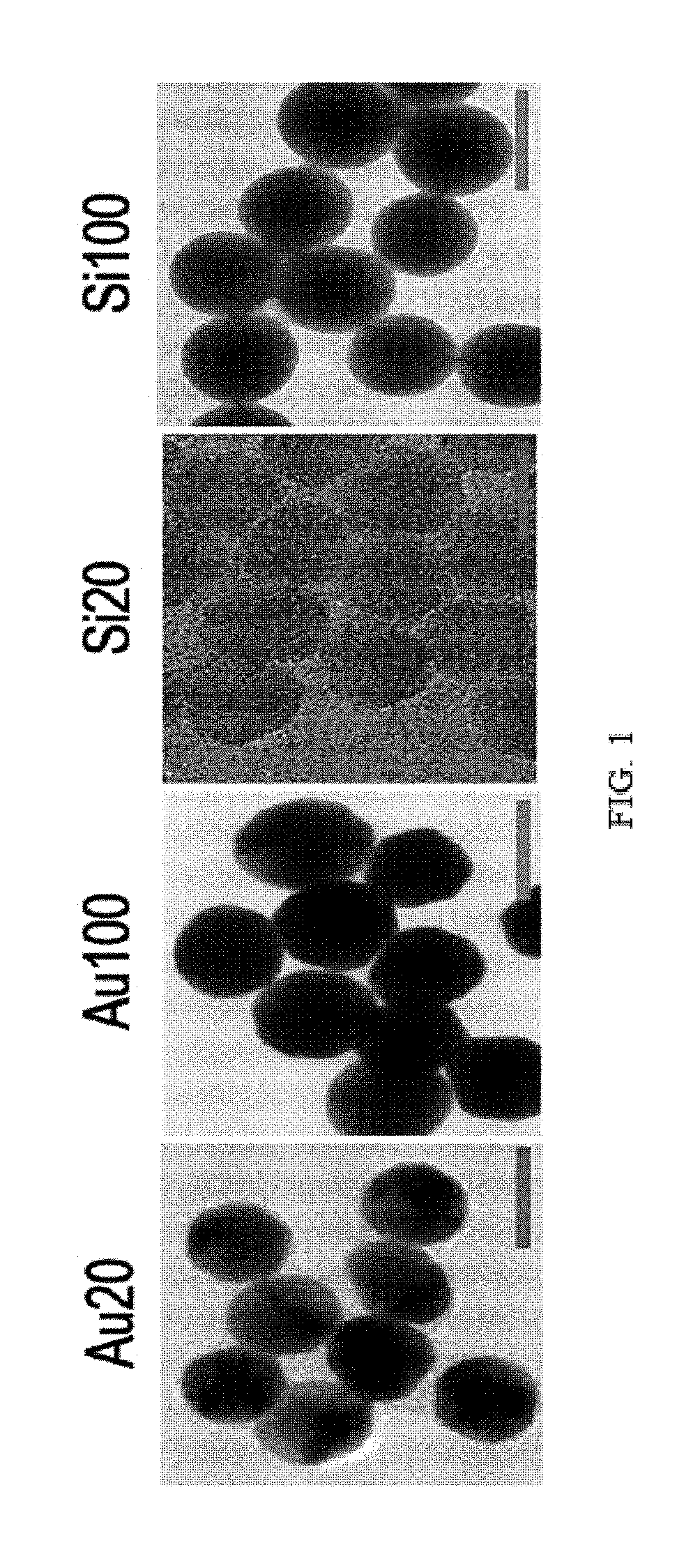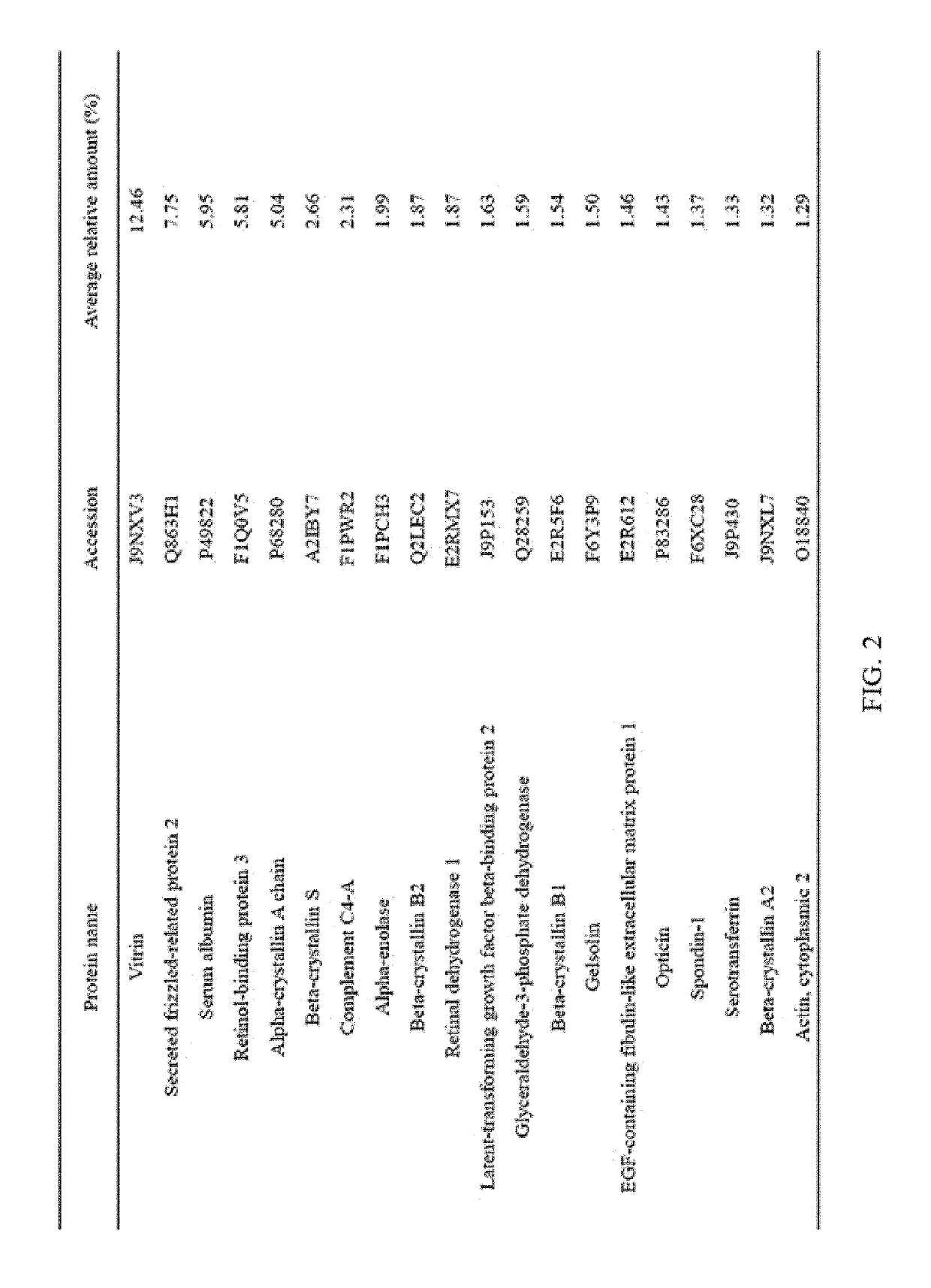Composition for inhibiting angiogenesis comprising nanoparticle-vitreous body-based protein complex as active ingredient, and use thereof
a technology of nanoparticles and proteins, applied in the direction of drug compositions, peptide/protein ingredients, microcapsules, etc., can solve the problems of diabetic retinopathy, prematurity retinopathy, angiogenesis in the retina, etc., and achieve the effect of inhibiting angiogenesis, excellent binding strength, and convenient us
- Summary
- Abstract
- Description
- Claims
- Application Information
AI Technical Summary
Benefits of technology
Problems solved by technology
Method used
Image
Examples
example 1
ion of Vitreous Body-Based Protein Binding to Nanoparticles
[0067]1-1. Preparation of Nanoparticles
[0068]As nanoparticles for binding to vitreous body-based proteins, gold and silica nanoparticles having a diameter of 20 nm and gold and silica nanoparticles having a diameter of 100 nm were prepared. Specific information and TEM images of the nanoparticles are shown in Table 1 and FIG. 1.
[0069]
TABLE 1Au20Au100Si20Si100Diameter (nm)18.99 ± 1.37 8.42 ± 7.2420.72 ± 1.48 2.28 ± 4.78Hydrodynamic24.66 ± 0.83112.16 ± 8.5319.79 ± 0.70130.04 ± 3.71Diameter (nm)Zeta potential (mV)−45.26 ± 1.46 −43.54 ± 0.41−52.96 ± 6.86 −45.94 ± 3.62
[0070]1-2. Binding Between Nanoparticles and Vitreous Body-Based Protein
[0071]Each of the gold (Au20) and silica (Si20) nanoparticles (1×1011) having a diameter of 20 nm and the gold (Au100) and silica (Si100) nanoparticles (1×1011) having a diameter of 100 nm, prepared through Example 1-1, and the vitreous body containing 170 μg of proteins were incubated in a micr...
example 2
of Nanoparticle-Vitreous Body-Based Protein Complex
[0073]A total 150 ng of proteins (SALVAR complex) consisting of the top 5 vitreous body-based proteins that were identified by Example 1-2 having weights of 50 ng, 25 ng, 25 ng, 25 ng, and 25 ng, respectively was prepared, and the total 150 ng of proteins and 1×109 nanoparticles were incubated at 4° C. for 1 hour while being rotated at 20 rpm to form a nanoparticle-vitreous body-based protein complex.
example 3
ion of Angiogenesis Inhibition Effect of Nanoparticle-Vitreous Body-Based Protein Complex
[0074]Gold and silica nanoparticles are known to bind to a vascular endothelial growth factor in water or in a cell culture. Thus, to verify whether the nanoparticle-vitreous body-based protein complex according to the present invention effectively binds to a vascular endothelial growth factor in water or in a cell culture as compared to such nanoparticles, an experiment was conducted as follows.
[0075]3-1. Comparison Between Binding Strengths with Vascular Endothelial Growth Factor in Water
[0076]The case of binding nanoparticles to a vascular endothelial growth factor in water was compared with the case of binding the nanoparticle-vitreous body-based protein complex to a vascular endothelial growth factor in water, and schematic processes for the corresponding experiment are illustrated in FIGS. 7A and 7B.
[0077]That is, nanoparticles or the nanoparticle-vitreous body-based protein complex and a ...
PUM
| Property | Measurement | Unit |
|---|---|---|
| diameter | aaaaa | aaaaa |
| diameter | aaaaa | aaaaa |
| diameter | aaaaa | aaaaa |
Abstract
Description
Claims
Application Information
 Login to View More
Login to View More - R&D Engineer
- R&D Manager
- IP Professional
- Industry Leading Data Capabilities
- Powerful AI technology
- Patent DNA Extraction
Browse by: Latest US Patents, China's latest patents, Technical Efficacy Thesaurus, Application Domain, Technology Topic, Popular Technical Reports.
© 2024 PatSnap. All rights reserved.Legal|Privacy policy|Modern Slavery Act Transparency Statement|Sitemap|About US| Contact US: help@patsnap.com










